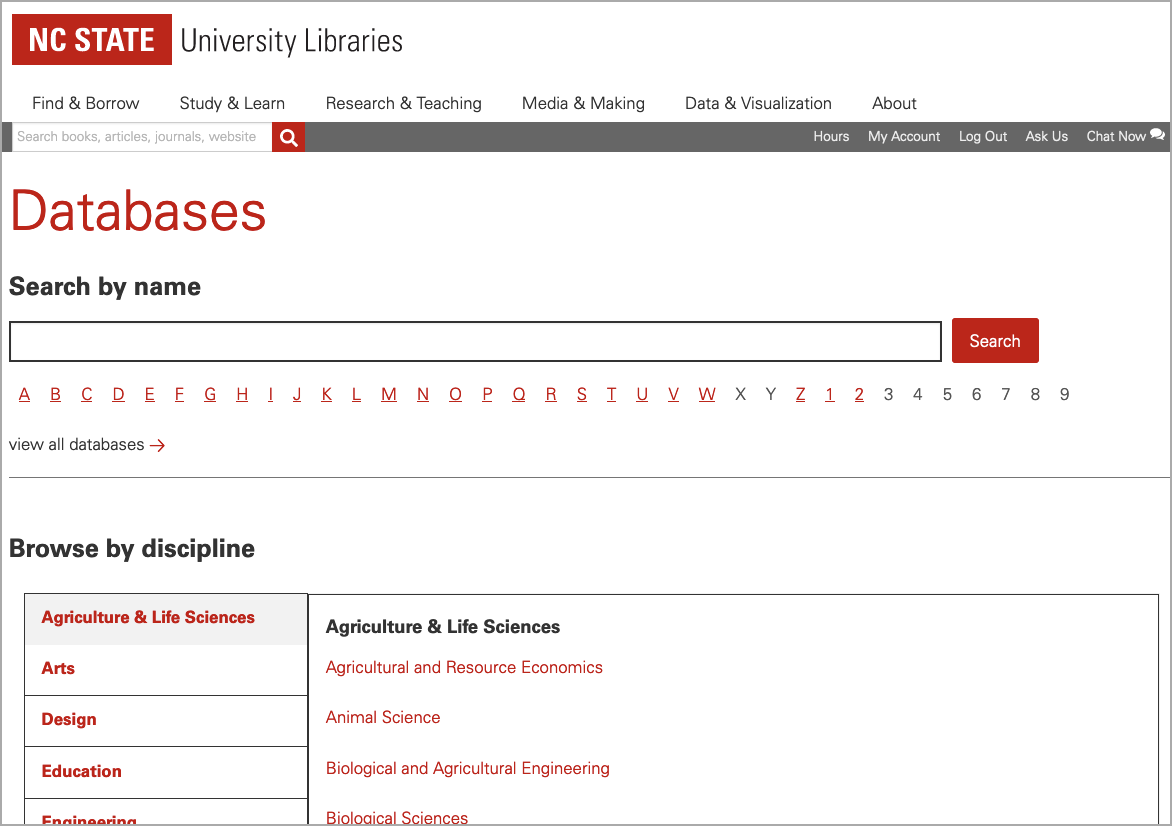Databases usability study
After launching our updated discovery platform for research databases, we conducted a set of usability tests and interviews to evaluate the success of the new application and discover opportunities for improvement.
Overview
The Libraries subscribes to over 700 research databases, which are used frequently by researchers and students across the university. In January 2021, the Journals & Databases product team migrated our discovery platform for these databases from a standalone application to the main Libraries website in Drupal.

This migration included a completely new taxonomy called “Disciplines” to enable subject-based discovery, which we built around the college and department structure at the university. The front-end design was very similar to the old application, with a few updates such as adding a search bar.
After a year of the new application being live, we wanted to evaluate our changes and gather user feedback to inform the next round of updates. We met with two students and two faculty members in Fall 2022 and Spring 2023, who each performed a set of tasks and answered some questions about their experience.
Successes
We were pleased to discover multiple ways in which the new application is easy to use and helps students & faculty find what they need quickly:
- Both students and faculty shared our meaning of the word “databases” to refer to searchable tools used for research.
- Finding databases by name was rated “Easy” by all participants, whether they used searching or browsing. Both methods seem to be working well for discovery of known databases.
- Faculty participants said that our terms for the disciplines, matching the university’s college/department structure, made it easy to find relevant databases. This was a lot of work to implement, and a bit of a gamble on the team’s part. It’s great to get confirmation from users that this is helpful to them.
Recommendations
We also discovered several opportunities for improvement:
- Change the layout of the disciplines browser on the main landing page. It wasn’t immediately clear to users that the left-hand tabs are used for navigation.
- Update the search box on the main landing page to return both databases and disciplines. Users tried searching for disciplines by name in this search box.
- Add a more descriptive label to the disciplines section on database node pages. The purpose of these links, and where they lead, wasn’t immediately clear to users.
- Consider unifying the presentation of links to discipline pages, rather than the three different designs currently in use. This could help alleviate the confusion we saw from some users about which links lead to which type of pages.
How We Did It
In Fall 2022 and Spring 2023, we conducted four user research sessions with two faculty members, one undergraduate student, and one graduate student. Each session was conducted over Zoom and consisted of a usability test and interview. The usability test included three tasks, one of which was optional based on time. Participants were asked to rate the difficulty of each task, and we then conducted a short interview to get more information about their use of databases and their experience with the application.
Team
 Meredith WynnWeb Developer
Meredith WynnWeb Developer Andreas OrphanidesLead Librarian for UX Strategy
Andreas OrphanidesLead Librarian for UX Strategy Bertha ChangAssociate Head, Collections & Research Engagement
Bertha ChangAssociate Head, Collections & Research Engagement Cindy LevineResearch Librarian for Humanities and Social Sciences
Cindy LevineResearch Librarian for Humanities and Social Sciences Tisha MentnechResearch Librarian for Agriculture and Life Sciences
Tisha MentnechResearch Librarian for Agriculture and Life Sciences Karen DeWittDirector, Design Library
Karen DeWittDirector, Design Library